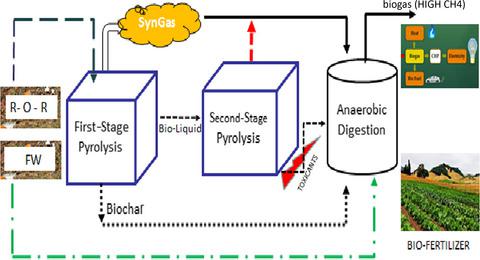当前位置:
X-MOL 学术
›
Energy Sci. Eng.
›
论文详情
Our official English website, www.x-mol.net, welcomes your feedback! (Note: you will need to create a separate account there.)
Pyrolysis coupled anaerobic digestion process for food waste and recalcitrant residues: Fundamentals, challenges, and considerations
Energy Science & Engineering ( IF 3.8 ) Pub Date : 2019-10-03 , DOI: 10.1002/ese3.503 Abdulmoseen Segun Giwa 1, 2 , Heng Xu 2, 3 , Fengmin Chang 2 , Xiaoqian Zhang 4 , Nasir Ali 5 , Jing Yuan 1 , Kaijun Wang 2
Energy Science & Engineering ( IF 3.8 ) Pub Date : 2019-10-03 , DOI: 10.1002/ese3.503 Abdulmoseen Segun Giwa 1, 2 , Heng Xu 2, 3 , Fengmin Chang 2 , Xiaoqian Zhang 4 , Nasir Ali 5 , Jing Yuan 1 , Kaijun Wang 2
Affiliation

|
Food waste (FW) is a severe environmental problem all over the world, and the recalcitrant organic residues (ROR) from FW treatment plant operations are also a critical environmental issue due to unsustainable treatment and disposal techniques. Requirements for FW and ROR complete exploitation with the establishment of recycling‐renewable technologies are very crucial. This paper review AD and pyrolysis as two promising technologies to degrade FW and its residues, creating numerous renewable bioenergy yields with value‐added. Existing oil/tar application methods in the AD suffered from various problems such as microorganism toxicity and limited productivity. Future upgrading techniques considering the second‐stage pyrolysis process to decompose oil/tars for syngas with high hydrogen content and enhanced bio‐methanation in the AD were addressed. Simultaneous pyrolysis by‐product recycle in the AD during the valorization of FW are aimed to have the features of sustainability toward increased bioenergy production, reactor efficiency, and agricultural application.
中文翻译:

热解耦合厌氧消化过程中的食物残渣和顽固性残留物:基本原理,挑战和注意事项
厨余(FW)是世界范围内的严重环境问题,由于不可持续的处理和处置技术,来自FW处理厂运营的顽固有机残留物(ROR)也是关键的环境问题。建立回收可再生技术对FW和ROR进行完全开发的要求非常关键。本文回顾了AD和热解技术,这是降解FW及其残留物的两种有前途的技术,可创造出许多具有附加值的可再生生物能源。AD中的现有油/焦油施用方法遭受各种问题,例如微生物毒性和生产率受限。解决了考虑第二阶段热解过程分解油/焦油的高氢含量合成气和增强AD中生物甲烷化的未来升级技术。
更新日期:2019-10-03
中文翻译:

热解耦合厌氧消化过程中的食物残渣和顽固性残留物:基本原理,挑战和注意事项
厨余(FW)是世界范围内的严重环境问题,由于不可持续的处理和处置技术,来自FW处理厂运营的顽固有机残留物(ROR)也是关键的环境问题。建立回收可再生技术对FW和ROR进行完全开发的要求非常关键。本文回顾了AD和热解技术,这是降解FW及其残留物的两种有前途的技术,可创造出许多具有附加值的可再生生物能源。AD中的现有油/焦油施用方法遭受各种问题,例如微生物毒性和生产率受限。解决了考虑第二阶段热解过程分解油/焦油的高氢含量合成气和增强AD中生物甲烷化的未来升级技术。


























 京公网安备 11010802027423号
京公网安备 11010802027423号